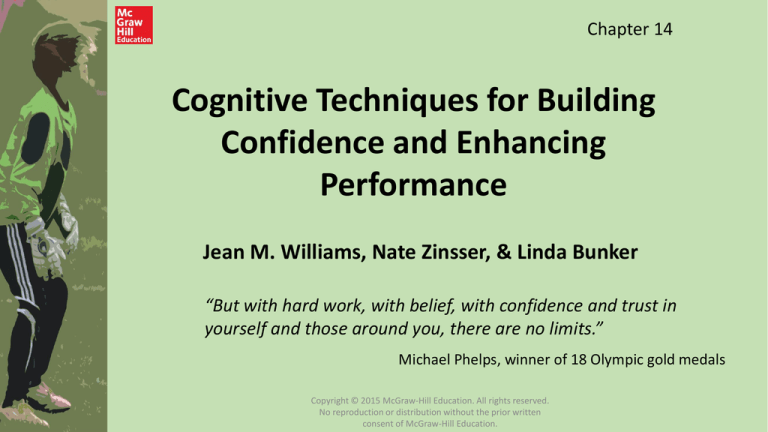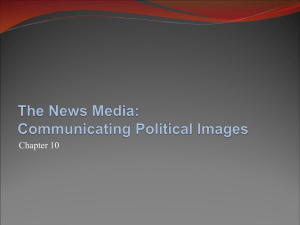
Chapter 14
Cognitive Techniques for Building
Confidence and Enhancing
Performance
Jean M. Williams, Nate Zinsser, & Linda Bunker
“But with hard work, with belief, with confidence and trust in
yourself and those around you, there are no limits.”
Michael Phelps, winner of 18 Olympic gold medals
Copyright © 2015 McGraw-Hill Education. All rights reserved.
No reproduction or distribution without the prior written
consent of McGraw-Hill Education.
Thoughts
Feelings
Behavior
• There is a direct correlation between self-confidence
and success
• Must understand confidence and how to enhance it in
athletes
• What is the relationship between thoughts and
confidence?
• How do self-talk and particular thinking habits
influence confidence?
Copyright © 2015 McGraw-Hill Education. All rights reserved. No
reproduction or distribution without the prior written consent of
McGraw-Hill Education.
Confidence
• Self-Confidence:
• Feeling of assurance
• Belief in one’s power
• Expectation of success
• Sport Confidence:
• An individuals’ belief that they can do
whatever it takes to be successful in their sport
Copyright © 2015 McGraw-Hill Education. All rights reserved. No
reproduction or distribution without the prior written consent of
McGraw-Hill Education.
Confident Athletes
• Have high:
• Mental toughness
• Optimism
• Self-efficacy
Copyright © 2015 McGraw-Hill Education. All rights reserved. No reproduction or distribution
without the prior written consent of McGraw-Hill Education.
Mental Toughness
– Related to confidence
– The unshakable belief in your ability to
achieve goals (Jones, Hanton, &
Connaugton )
– The way some athletes can remain more
determined, focused, confident, and in
control better than competitors
– Belief + Focus
Copyright © 2015 McGraw-Hill Education. All rights reserved. No
reproduction or distribution without the prior written consent of
McGraw-Hill Education.
Optimism
• Also related to confidence
• Expect the best possible outcome
• Focus on the most hopeful aspects of a situation
• In sport, it means looking for opportunities to score,
win, and excel
Copyright © 2015 McGraw-Hill Education. All rights reserved. No
reproduction or distribution without the prior written consent of
McGraw-Hill Education.
Self-Efficacy
• Situational-specific type of
confidence
• Having the expectation of
succeeding at a specific task or
meeting a particular challenge
Copyright © 2015 McGraw-Hill Education. All rights reserved. No
reproduction or distribution without the prior written consent of
McGraw-Hill Education.
Misconceptions about Confidence
• Either you have it or you don’t
• Only positive feedback can build confidence
• Success always builds confidence
• Confidence = outspoken arrogance
• Mistakes inevitably destroy confidence
Copyright © 2015 McGraw-Hill Education. All rights reserved. No
reproduction or distribution without the prior written consent of
McGraw-Hill Education.
Prerequisites for Gaining Confidence
1. Understanding the interaction of thought
and performance
• Confident athletes deliberately direct
thoughts to produce powerful feelings
improves performance
2. Cultivate honest self-awareness
• “Am I really thinking in a way that will give
me the best chance of success?”
Copyright © 2015 McGraw-Hill Education. All rights reserved. No
reproduction or distribution without the prior written consent of
McGraw-Hill Education.
Prerequisites for Gaining Confidence (cont.)
3. Develop an optimistic explanatory style
• Explanatory style = the way an athlete internally
responds to events that occur in his or her life
• Optimistic explanatory style views errors as
temporary and atypical, views successes as more
permanent, general, and indicative of true ability
• Explanatory style has 3 dimensions:
• Permanence
• Pervasiveness
• Personalization
Copyright © 2015 McGraw-Hill Education. All rights reserved. No
reproduction or distribution without the prior written consent of
McGraw-Hill Education.
Prerequisites for Gaining Confidence
(cont.)
4. Embrace a psychology of excellence
• Go for your dreams
• Focus on your successes
• Be your best friend, biggest fan and greatest
coach
• Create your own reality
Copyright © 2015 McGraw-Hill Education. All rights reserved. No
reproduction or distribution without the prior written consent of
McGraw-Hill Education.
Self-Talk
• Dialogue with yourself
• Giving yourself instructions and reinforcement or
interpreting what you are feeling
• Can be out loud or inside your head
• Self-talk is an asset when it enhances self-worth and
performance
• Key to cognitive control
Copyright © 2015 McGraw-Hill Education. All rights reserved. No
reproduction or distribution without the prior written consent of
McGraw-Hill Education.
Constructive vs. Destructive Self-Talk
• Constructive:
•
•
•
•
Fosters positive expectancies
Enhances self-worth and confidence
Enhances performance
Appropriately focuses attention on the task
• Destructive:
•
•
•
•
Focuses on what you don’t want (usually is negative)
Distracting to the task at hand
So frequent it disrupts automatic performance
Engage in derogatory self-labeling (e.g. loser, choker)
Copyright © 2015 McGraw-Hill Education. All rights reserved. No
reproduction or distribution without the prior written consent of
McGraw-Hill Education.
Uses for Self-Talk
• Skill acquisition and performance
• Use words to cue action
• Learning: technique cue words
• As skills improve: strategies/feeling cues
• Self-talk to direct attentional focus
• Changing bad habits
• Focus on desired outcome vs. error
Copyright © 2015 McGraw-Hill Education. All rights reserved. No
reproduction or distribution without the prior written consent of
McGraw-Hill Education.
Uses for Self-Talk (cont.)
• Attention control
• Remain in the present tense
• Create/change affect or mood
• Control effort
• Building self-efficacy and confidence
• Adoption/maintenance exercise behavior
Copyright © 2015 McGraw-Hill Education. All rights reserved. No
reproduction or distribution without the prior written consent of
McGraw-Hill Education.
Identifying Self-Talk
• Athletes need to develop awareness around the ways
in which they talk to themselves in different types of
situations
• Identify what kind of thinking helps, what
thoughts are harmful, and what situations are
associated with this talk
• Must know when and how to talk to yourself
Copyright © 2015 McGraw-Hill Education. All rights reserved. No
reproduction or distribution without the prior written consent of
McGraw-Hill Education.
3 effective tools for identifying self-talk
1. Retrospection
• Re-create the thoughts and feelings that occurred prior
to and during a good or bad performance
• Recall the specific circumstances that led to the
thoughts and resulting performance
2. Imagery
• Recreating all relevant sensory experiences of a past
performance
3. Self-talk log
• Keep a thought awareness logbook
• What do I say before, during, and following my good
and poor performances?
• How frequently
am I talking to myself?
Copyright © 2015 McGraw-Hill Education. All rights reserved. No
reproduction or distribution without the prior written consent of
McGraw-Hill Education.
Techniques for Controlling Self-Talk
• Thought stoppage
• Changing negative thoughts to positive
thoughts
• Countering
• Reframing
• ABC cognitive restructuring
• Affirmation statements
• Mastery and coping tapes
• Video technology
Copyright © 2015 McGraw-Hill Education. All rights reserved. No
reproduction or distribution without the prior written consent of
McGraw-Hill Education.
Thought Stoppage
• Method for eliminating counterproductive
thoughts
• Become aware of unwanted thought
• Use a trigger to interrupt or stop the
undesirable thought
• Practice by combining it with imagery
of past performance
• Might be difficult for some to suppress
an unwanted thought
• Beware: focusing on suppressing
unwanted thoughts can increase them
Copyright © 2015 McGraw-Hill Education. All rights reserved. No
reproduction or distribution without the prior written consent of
McGraw-Hill Education.
Changing Negative Thoughts to Positive
Thoughts
• Use when thought stoppage does not work
• Learn to couple any negative thought with a
positive thought that provides support or
appropriately redirects attention
• Switch to a positive thought as soon as you
are aware of a dysfunctional self-statement
• Combine this technique with a relaxation
• Stop the negative thought
• Take a deep breath
• Slowly exhale and substitute the selfenhancing thought as body relaxes
Copyright © 2015 McGraw-Hill Education. All rights reserved. No
reproduction or distribution without the prior written consent of
McGraw-Hill Education.
Countering
• An internal dialogue that uses facts and reasons to
refute the underlying beliefs and assumptions that led
to negative thinking
• Use this technique if the athlete still believes in the
negative statements
• Identify and build a case against the negative selfstatements
• Use past evidence and future possibilities to refute
underlying beliefs that led to dysfunctional thinking
• Argue against the dysfunctional and for the more
functional self-talk
Copyright © 2015 McGraw-Hill Education. All rights reserved. No
reproduction or distribution without the prior written consent of
McGraw-Hill Education.
Reframing
• The process of creating alternative frames of
reference or different ways of looking at the world
• Interpret situations in a more positive way
• Can transform weakness/difficulty into a strength
/possibility
• Does not deny or downplay what the athlete is
experiencing or encourage the athlete to ignore
something troublesome
Copyright © 2015 McGraw-Hill Education. All rights reserved. No
reproduction or distribution without the prior written consent of
McGraw-Hill Education.
Irrational and Distorted Beliefs
• Perfection is essential: Must be thoroughly
competent, successful, and achieving in all possible
respects
• Catastrophizing: Expect disaster, worst-case scenario
(awfulizing)
• Worth depends on achievement: You are your
accomplishments
• Personalization: Everything is some kind of
reaction to you
Copyright © 2015 McGraw-Hill Education. All rights reserved. No
reproduction or distribution without the prior written consent of
McGraw-Hill Education.
Irrational and Distorted Beliefs (cont.)
• Fallacy of fairness and ideal conditions: Expect fair
treatment/ideal conditions and resentful when others
don’t agree with your definition of fairness
• Blaming: Make excuses/blame others or, at the other
extreme, unreasonable self-blame
• All-or-nothing thinking and labeling: No shades of grey
– often judgmental and prone to negative labels.
Copyright © 2015 McGraw-Hill Education. All rights reserved. No
reproduction or distribution without the prior written consent of
McGraw-Hill Education.
Irrational and Distorted Beliefs (cont.)
• One-trial generalizations: Form general conclusions
based on a single incident or piece of evidence
• Shoulds: List of ironclad rules for behaviour - get
angry or feel guilty when violated
• Emotional reasoning: What you feel must be true
Copyright © 2015 McGraw-Hill Education. All rights reserved. No
reproduction or distribution without the prior written consent of
McGraw-Hill Education.
Modifying Irrational and Distorted
Thinking
• ABC Cognitive Restructuring
• Based on REBT by Albert Ellis
• Helps identify and dispute irrational beliefs in maladaptive
thinking
• The idea is that it’s faulty thinking, not the situation, causes
the deleterious emotional reaction and behavior
• The ultimate goal = create such awareness that athletes
immediately recognize and dispute dysfunctional self-talk
Copyright © 2015 McGraw-Hill Education. All rights reserved. No
reproduction or distribution without the prior written consent of
McGraw-Hill Education.
ABC Cognitive Restructuring
Copyright © 2015 McGraw-Hill Education. All rights reserved. No
reproduction or distribution without the prior written consent of
McGraw-Hill Education.
Affirmation Statements
• Statement that reflect positive attitudes or thoughts about
oneself
• Positive action-oriented statement
• The most effective affirmations are both believable and
vivid
• State in present tense and avoid perfectionistic demands
• Use a self-esteem list to help create affirmations
• Write/say many times
• Once the affirmation becomes true, choose another and
begin again
Copyright © 2015 McGraw-Hill Education. All rights reserved. No
reproduction or distribution without the prior written consent of
McGraw-Hill Education.
Coping and Mastery Self-Talk
Tapes or Files
• Mastery self-talk tape/file:
• Voice describes a perfect performance including ideal
thoughts, feelings, and emotions experienced just
before, during, and after performance
• Coping self-talk tape/file:
• Allows the athlete to practice dealing with all the
potential things that could go wrong by describing a
negative situation and bad reaction but then rehearsing
coping strategies and processes for regaining
control/confidence
Copyright © 2015 McGraw-Hill Education. All rights reserved. No
reproduction or distribution without the prior written consent of
Coping and Mastery Self-Talk
Tapes or Files (cont.)
• Videotape, CDs, or DVDs:
• Splice personal or team highlights (select performances where
athletes excel at the skills or strategies currently needing emphasis);
watch many times while imaging the action, with accompanying
emotions and self-talk
Copyright © 2015 McGraw-Hill Education. All rights reserved. No
reproduction or distribution without the prior written consent of
McGraw-Hill Education.









